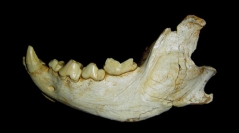

 Comptes Rendus Palevol
6 (4) - Pages 241-251
Comptes Rendus Palevol
6 (4) - Pages 241-251The Marie cave, discovered to the north of Montpellier, Hérault (France), has yielded a fauna of 28 vertebrates, out of which 23 are small to large mammals, notably Mammuthus primigenius . The few discovered artefacts have been attributed to the Upper Palaeolithic, which is in agreement with the two radiocarbon dates (31450 14C yr BP for the low level, and 28680 14C yr BP near the cave's entrance). The palynological study shows the existence (i) of a wooded steppe on the plateau, and (ii) of a riverine forest with alders in the valleys, associated with Mediterranean taxa. These data confirm the presence in Languedoc of Mediterranean species around 30000 yr BP, which qualifies the hypothesis of exclusively Spanish and Italian refuges during glacial periods.
Marie cave, vertebrates, palynology, palaeoenvironment, Upper Palaeolithic, Würm, France